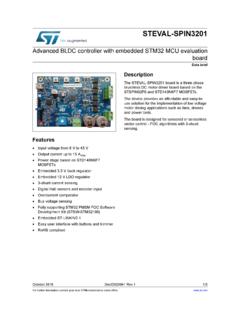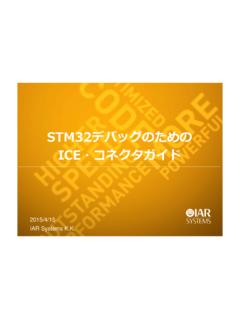Transcription of STM32 & USB - www.emcu.it
1 STM32 & USB Roman LudinSeptember 2014 Ver. Universal Serial Bus The USB -Universal Serial Bus is an industry standard developedin the mid-1990s that defines Bus architecture Cables, Connectors, Electrical levels Communications protocols 3 USB was designed to standardizethe connection of computer peripherals keyboards, pointing devices, digital cameras, printers, portable media players, disk drives and network adapters It has become common interface on other devices, such as smartphones, PDAs and video game consoles. USB has effectively replaceda variety of earlier interfaces, such as serial and parallel Universal Serial Bus4 Hot pluggableYESP rotocol Serial, pooled, host 12/ 480/ 5,000/ 10,000 Mbit/sMax Length5mMax Voltage5 VMax general5A charging deviceMax Devices 127 Pins41 supply, 2 data, 1 ground TopologyTired star USB History The original USB was introduced in January 1996 Defined data transfer rates of Mbit/s Low Speed" and 12 Mbit/s"Full Speed The first widely used version of USB was , was released in September 1998.
2 The USB was released in April 2000 Develop a higher data transfer rate achieving 480 Mbit/s a 40-times increase over the original USB specification The USB was published on 12 November 2008. Increase the data transfer rate (up to 5 Gbit/s) decrease power consumption, increase power output backwards-compatible with USB includes a new, higher speed bus called SuperSpeedin parallel with the USB bus. The USB specification was released on 31 July 2013 Introducing a faster transfer mode called "SuperSpeedUSB 10 Gbps" USB Implementers Forum, Inc. is a non-profit corporation that developedthe USB specification The Forum facilitates the development of high-quality compatible USB peripherals (devices), and the quality of products that have passed compliance testing.
3 Some of the many activities that the USB-IF supports include: USB ComplianceWorkshopsand compliance testand tool development USB Developer Conferences Assignment of a vendor ID Web site and many Bus Topology The USB physical interconnect is a tiered star topology. The USB connectsUSB devices with the USB host. A hub is at the centerof each star. Each wire segment is a point-to-point connection. The maximum of 127devicescan be connected in the bus The maximum of 5 hubs can be connected in series The maximum number of tiers allowed is seven The maximum cable length is 5meter7 Electrical USB is a serial bus, using fourshielded wiresfor the USB variant: two for power (VBUS and GND), two for differential data signals (D+ and D-).
4 Non-Return-to-Zero Inverted (NRZI) encoding scheme is used for transferring USB specification provides the mechanicaland electrical specifications for the cables, connectors The USB physical topology consists of connecting the downstream hub port to the upstream port of another hub or to a device keyed connector are used to minimize end user termination problemsStandard, Mini, and Micro USB the "host" systemdownstream towards the USB DeviceUSB over STM32 FamilyMCUCoreUSB controllerSTM32L0x2 STM32L0x3 Cortex-M0+1x Crystal lessUSB FS devicewithLink Power Managament(LPM) and BatteryCharger detection(BCD)STM32F0x2 STM32F0x8 Cortex-M01x Crystal lessUSB FS devicecontrollerwithLink Power Managment(LPM) and BatteryCharger detection(BCD)
5 STM32L1 Cortex-M31x USB FS device with internal 48 MHz PLLSTM32F102/103 Cortex-M31x USB FS devicecontrollerSTM32F105/107 Cortex-M31x USB FS device/host/OTG controller with on-chip PHY with Kbytes of dedicated SRAMSTM32F2 Cortex-M31x USB FS device/host/OTG controller with on-chip PHY1x USB FS/HS device/host/OTG controller with dedicatedDMA, on-chip full-speed PHY and ULPSTM32F3 Cortex-M41x USB FS devicecontrollerand LPMSTM32F4 Cortex-M41x USB FS device/host/OTG controller with on-chip PHY1x USB FS/HS device/host/OTG controller with dedicatedDMA, on-chip full-speed PHY and ULPI10 STM32 on USB-IF integrators list11 VID/PID sublicensing serviceProcess & Schedule for PID request Request details:1) COMPANY NAME AUTHORZING USE TO : 2) Contact Name /Address and E-mail address:3) Name/Sales type of the STMicrocontrollerproduct name :4) Name of USB end-product : { if possible USB device string Product} PID Booked in an internal ST Database By end of each quarter ST send the approval list to the USB-IF Approval by USB-IF PID send to the customer with a letter form Agreement 12 USB peripheral(F0/L0) Crystal-less*USB FS interface (12 Mbit/s) Integrated on-chip 48 MHz oscillator with clock recovery system.
6 No external resonator/ crystal needed (cost saving is in range of $). Up to 16 mono-directional or 8 bidirectional configurable endpoints Up to 1024 Bytes of dedicated packet buffer memory SRAM Complies with Link Power Management feature (LPM) and Battery Charging Detection(BCD) specification Device Firmware Upgrade on the field over USB (boot loader) USB FS Device Library with intuitive USB device class drivers API Examples and demo based on a set of 6 classes (Audio, CCID, CDC, HID, VCP, MSC). Easy development of applications using USB full speed transfer types (control, interrupt, bulk and isochronous). Free PID/VID program for end-product certification13(USB) Clock recovery principle Provide the precise USB clock (48 Mhz @ ) without any external resonator.
7 It uses the USB Start-of-Frame (SOF) sent by a host at precise 1ms intervals ( accurate), as a timing reference. SOF timing reference allows to automatically trim the int48 MHz RC frequency based on the actual frequency error measured by a counter. HSI48 oscillator trimming step is typical ( max) to guarantee with a good margin the accuracy needed for USB. Other synchronization sources (LSE, extpin or SW trigger) works : to calcul the precisionof the output, + of error must be added on top of the reference signal precision. Ex : to reach output, you need to have at worst reference BatteryChargingDetection(USB BCD) Battery Charging Specification introduces new port definitions Standard downstream port (SDP)same port as defined by the USB spec.
8 Charging downstream port (CDP)normal port with extended current capability Dedicated charging port (DCP)car / wall charger, not able to enumerate STM32F0x2 identifies the nature of the USB host (SDP, CDP, DCP) and itspower source capability(..100mA, 500mA, etc) Typicaluse-case isto speed-up batterychargingof portable devicesconnectedto the USB Link Power Management (LPM) LPM is a new power-saving state called Sleep , with fast entry and exit times, compared to traditional Suspend mode. Benefits : Power consumption optimization across both the host and USB devices while idle, and extend battery life of hand-held applications. 18 Entry : ~ 3msExist : > 20 ms(Resume signaling) + 10 ms(Resume recovery)The existing suspend/resume mechanisms have been proven to be inadequate for current and future generation mobile platforms.
9 The bus-imposed resume latencies are so long that the mechanism doesn t support response times that are useful in many applications, especially in hand-held platformsMiddleware USB ST provides a complete offer for STM3219 Universal Serial Bus requires a dedicated software stack. This serial bus is organized in a star topology with host and device roles, host organizing the traffic. Several device classes are specified, in order to ease communication in different application seen acronymsOTGOn-The-Go: An OTG peripheralcan switch host and device role on the flyHUBD efineswhat protocols to implement to build a hub applicationMSMass storage: Protocols to interactwith storage block devices (for files)HIDH uman interface device: Protocols for peripherals interacting with human body (mouse,keyboard, etc.)
10 CDCC ommunication device class: Protocols for serial communications,different sub-classes define details, for instance ACM for a standard COM port, or ECM for modemsPrinterDefineswhat protocols to implement to build a printer applicationAudioDefineswhat protocols to implement to build an audio application (microphone, headset, etc.)DFUD evice firmware upgrade: Protocolsto implement firmware upgrade abilitySTM32 USB solutions (1/2)20 ProviderSolution nameModelCostAvailabilityF1F2F3F4L1 CMXCMX-USB Device,HostSourceLicense YYYYYEUROSUSB Host & DeviceBinariesLicenseYYYYYE xpress LogicUSBXS ourceLicense YYYYYHCCHCC-USBS ourceLicense YYYYYJ ungoUSBwareSourceLicense +royaltiesOn demandKeil/ARMMDK-ARM USBS ourceLicense YYYYYM entor EmbeddedNucleus USBS ourceLicenseYYYYYM icrium C/USBS ourceLicense YYYYYM icroDigitalsmxUSBS ourceLicense YYYYYQ uadrosRTXCusbSourceLicense YYYYN1 RowebotsUnison USB SystemSourceLicense YYYYYSEGGERemUSBS ourceLicense YYYYY1/ Available on customer request.







